Highland Games
The origin of these gatherings goes back to the Middle
Ages when clan chiefs wanted to see who
were the most talented or strongest men in his clan to recruit them as
bodyguards, musicians, dancers, or wrestlers. Today it is a sports competition
and a reason for coming together.
One of the most famous gatherings is held
each year at Braemar in Aberdeenshire during early September, opening with a
spectacular march of kilted clansmen accompanied by pipers playing the bagpipes.
The events are the following:
Tossing the caber
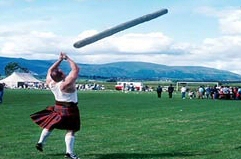
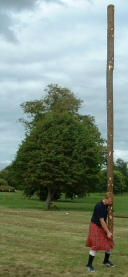 The caber looks like a telephone
pole. It ranges in weight from 30 to 120 pounds, and can be anything from 12 to
19 feet long. To "toss the caber" the contestant lifts the pole
vertically and rests it on his shoulder. He takes a few steps forward, then
flips the caber up and forward. The idea is to spin the log so that it falls
straight ahead. This event requires much skill, and is not just brute strength.
Each contestant
starts with the lightest, shortest caber, and if they successfully toss that,
go on to the next size, until either they are eliminated or they win.
The caber looks like a telephone
pole. It ranges in weight from 30 to 120 pounds, and can be anything from 12 to
19 feet long. To "toss the caber" the contestant lifts the pole
vertically and rests it on his shoulder. He takes a few steps forward, then
flips the caber up and forward. The idea is to spin the log so that it falls
straight ahead. This event requires much skill, and is not just brute strength.
Each contestant
starts with the lightest, shortest caber, and if they successfully toss that,
go on to the next size, until either they are eliminated or they win.
The Stone Put
 Like the conventional Shot Put, only
a stone is used instead of a metal shot. Men throw a 17 pound stone (7.7 kg),
women a 11 pound stone. The technique is different too from athletics. The
putter must keep one foot stationary, and cannot move across the throwing
circle. The world record for a stone put in this Braemar
style of putting is around 63 feet (~20 m).
Like the conventional Shot Put, only
a stone is used instead of a metal shot. Men throw a 17 pound stone (7.7 kg),
women a 11 pound stone. The technique is different too from athletics. The
putter must keep one foot stationary, and cannot move across the throwing
circle. The world record for a stone put in this Braemar
style of putting is around 63 feet (~20 m).
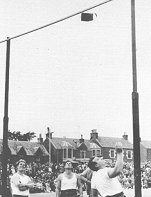 Weight For Height
Weight For Height
The metal weight (usually 56 pounds for men (25 kg), 28 pounds for women) has to be tossed, using one hand only, over a high cross bar.
Weight For Distance
A hammer type of weight (28 pounds, 13 kg) has to be thrown one handed over as long a distance as possible. The thrower is only allowed one and a half revolutions of his body before releasing the hammer.
Track Events
The track events are usually the
following: Running, Cycling, Jumping and of course Tug-o-War.
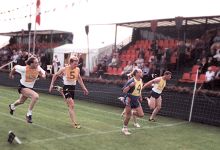
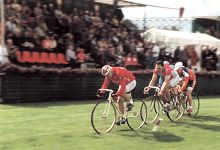
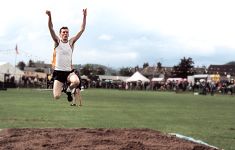

Piping
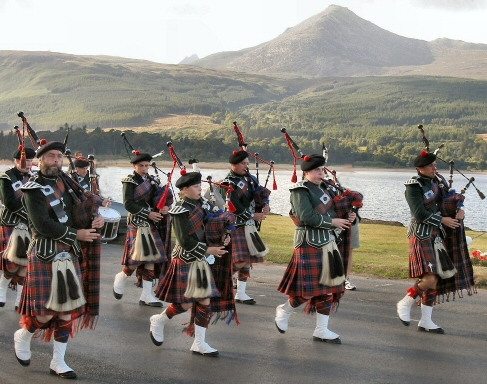 Visitors to Highland Gatherings will
see and hear two types of competition piping - solo piping and that
of the large Pipe Bands. In the competitions, bands play a mixture of marches for three
to nine minutes,
dependent upon the grade in which they are competing. In solo piping the most
valuable prizes are usually for Piobaireachd (pronounced
peebroch and in writing, Anglicised to pibroch) which although meaning simply pipe music, has come
to be applied to the classical music of the bagpipes.
Visitors to Highland Gatherings will
see and hear two types of competition piping - solo piping and that
of the large Pipe Bands. In the competitions, bands play a mixture of marches for three
to nine minutes,
dependent upon the grade in which they are competing. In solo piping the most
valuable prizes are usually for Piobaireachd (pronounced
peebroch and in writing, Anglicised to pibroch) which although meaning simply pipe music, has come
to be applied to the classical music of the bagpipes.
Dancing
source and credits
Photo of sword dancing © Michele Anderson 2005
Video clips: ElectricScotland © Alastair McIntyre 2006

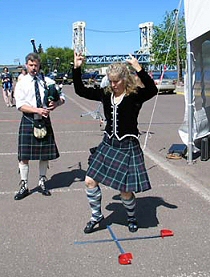 Said to have originated in 1054 when
King Malcolm
Said to have originated in 1054 when
King Malcolm  Together with the Sword Dance, the
Highland Fling is probably the most famous of Scottish dances. Thought to have
originated in about 1790, legend has it that an old shepherd was giving chanter
lessons to his grandson on a hillside when he saw a stag rearing and wheeling
in the near distance. He asked the boy if he could imitate the stag's dance
which he did, and hence the steps and the graceful curve of the arms and hands
depicting the stag's antlers. The dance is performed on the same spot
Together with the Sword Dance, the
Highland Fling is probably the most famous of Scottish dances. Thought to have
originated in about 1790, legend has it that an old shepherd was giving chanter
lessons to his grandson on a hillside when he saw a stag rearing and wheeling
in the near distance. He asked the boy if he could imitate the stag's dance
which he did, and hence the steps and the graceful curve of the arms and hands
depicting the stag's antlers. The dance is performed on the same spot